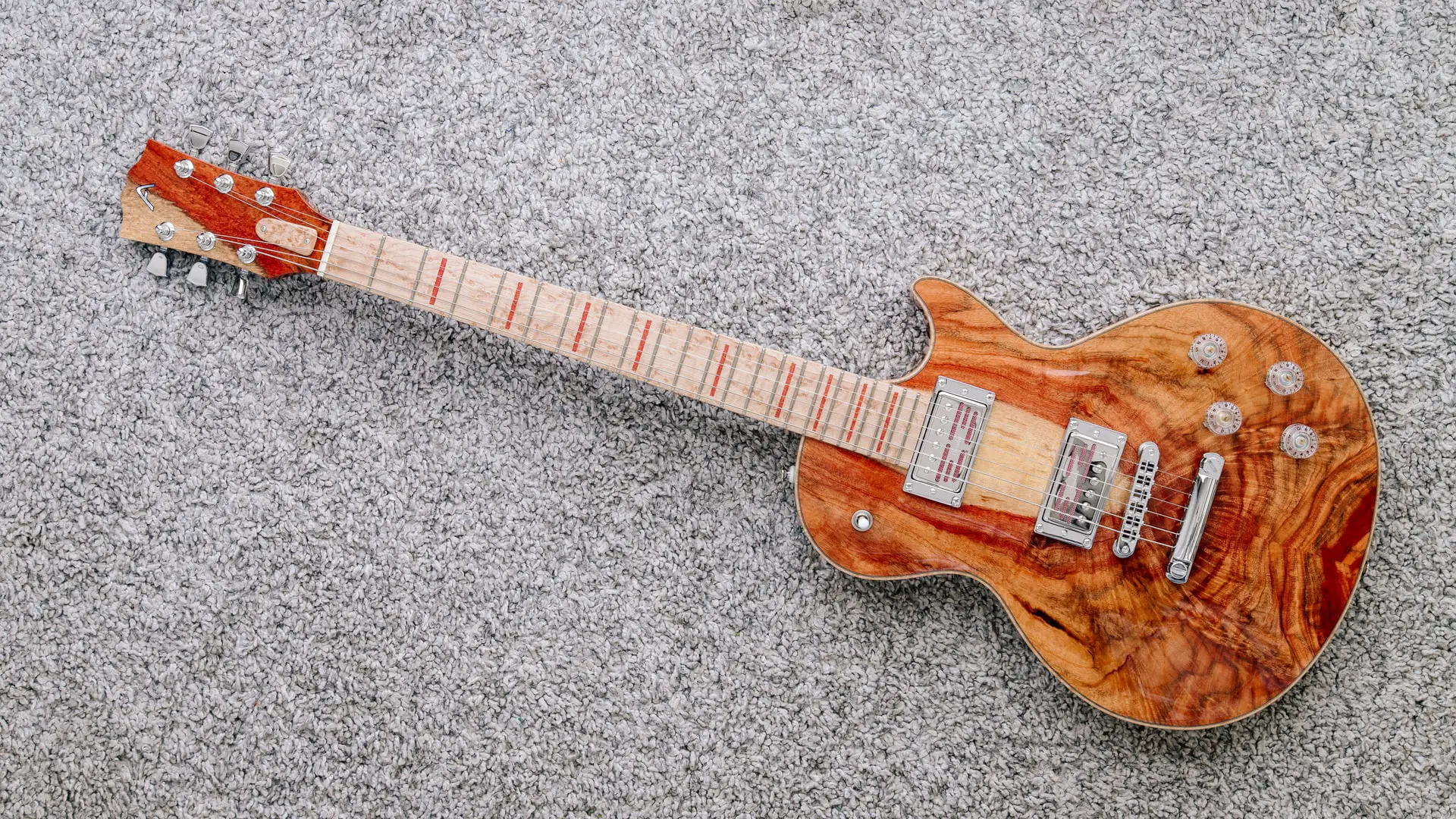To relic a maple guitar neck, you need to use sand paper, sharp knife and pencil to create scratches and dings. Then make it look naturally dark yellow by applying layers of Tru oil.
I am personally interested in relicing my Poly finish guitar as well. I have done plenty of research and compiled the best methods to relic a guitar neck in this article.
I initially researched it for my guitar but the list became quite extensive – so I thought why not share it?
I will also cover other related topics like different ways to turn maple neck dark yellow and other natural ways like sun and cigarette smoke. I hope this article is useful to you.
If you are interested in relicing the guitar body instead, then I have another article for that here. In this article, I will focus solely on maple guitar necks
How To Relic a Maple Guitar Neck (To Darken Yellow)
This step should work for both poly and nitro finish necks. And relicing the neck here includes neck, fretboard and headstock.
By the end, it should turn your white maple neck into dark yellow with natural looking scratches and dings on the headstock and fretboard like below.
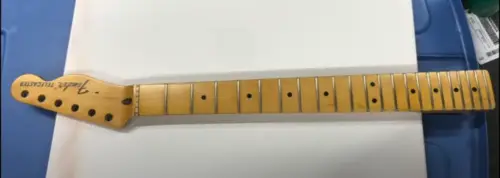
Using Tru Oil on a maple neck can turn it dark yellow like this.
1. Remove neck and string from guitar body
To begin relicing the neck, you need to detach the guitar neck from the body. You should also remove all the strings and tuners because we need to work on those areas a lot.
You can remove the guitar neck from the body by unscrewing some screws on the back of the guitar – all you need is a screwdriver. Nothing fancy.
To remove the guitar strings, you need to loosen each tuner and remove it from the headstock. Now is also a good time to switch your strings if they are old enough.
Relicing a guitar will not change its sound or tone – it’s all for cosmetics. But changing the string of a guitar can definitely impact tone and improve sound.
2. Remove existing finish with sandpaper
Use sandpaper to remove the existing finish on your guitar neck, fretboard and headstock. You need to use 320, 600 and 800 grit sandpaper in that order (do it 3 times for each sandpaper).
Using sandpaper on a guitar neck will make it feel much smoother and naturally aged when you finish it with Tru Oil coating later on.
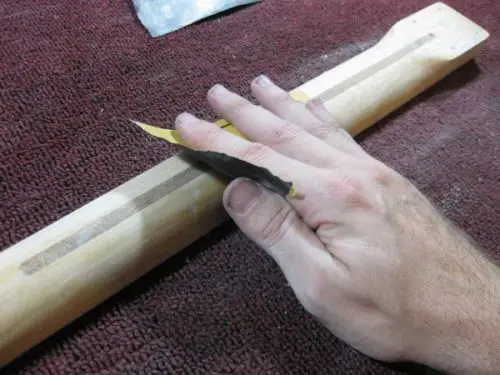
Use sand paper to remove the finish on your guitar neck.
3. Create dings and scratches on headstock
Use sandpaper to smoothen out the edges of the headstock to make it look aged. And use sharp tools like a craft knife to create dings and scratches.
The headstocks on most new guitars are quite sharp on the edges. Use 800 grit sandpaper to smoothen them out to your liking.
You can then use pliers, small rocks or craft knives to create small dings on the headstock and around the edges. Apply some shoe polish on those scratch areas to make it look realistic.
Tip: Google search a photo of a reliced headstock before you start and use that as a reference when you create the scratches – this helps guide you and make the scratches look natural.
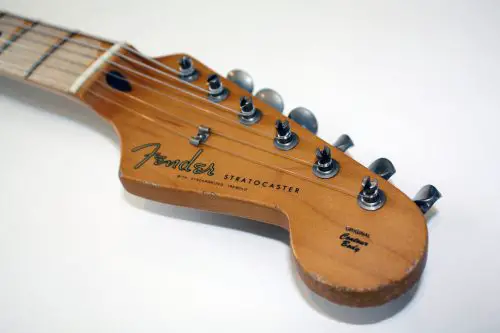
Refer to an image of a reliced headstock and create the same scratches and dings.
4. Create scratches and finger wear on fretboard
Use a sharp knife to peel off the finish and wood on your fretboard to simulate finger wear. And then use a pencil to turn it dark for a more natural feel.
Pay attention to where you usually play on the fretboard. Most people play more on the lower frets (near the headstock) – which means you need more scratches and ‘finger wear’ on those areas.
Again, Google search a photo of a reliced fretboard and use it as a reference. The idea of using a pencil to darken the scratches from your knife is the key for that natural wear look.
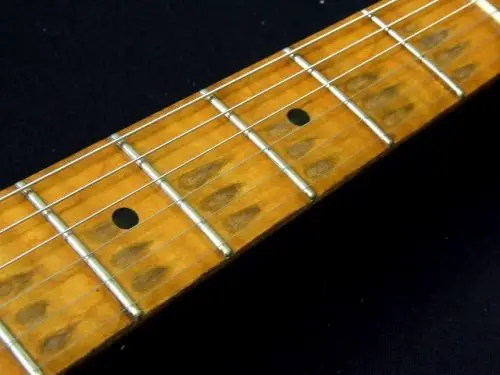
Use online image of a reliced fretboard to create similar finger marks. Use knife to peel the finish and use pencil to darken it.
5. Darken and finish the entire neck
Use tru oil to darken the entire neck and headstock to finish the relicing process. You need to use multiple layers of tru oil – I recommend 4 coats (10 minutes before each coat).
Make sure the entire neck, headstock and fretboard are clean before you apply the Tru oil. This is the last step that will package all your relicing effort into a natural look – don’t skip this part.
I see a lot of people having success when using Birchwood Casey Truoil (Gun Stock Finish). I suggest you pick that up as well.
The guitar neck should look like this after applying Tru oil and leaving it to dry. It looks dark yellow and slightly glossy – very natural. Your scratches and dings should also stay and look great.
Will Maple Necks Darken Naturally Over Time?
Guitar maple necks will naturally darken over time. It will turn from white into dark yellow-ish colour.
However, this natural darkening will take a long time – even longer for poly finish guitars. I expect the yellowing and darkening process to show after about 5 years or so for poly finish (depending on the environment).
For Nitro finish guitars, I expect the yellowing process to start showing after 2-3 years.
Maple necks will naturally darken and turn yellow because of the exposure from sunlight, cigarette smokes or even changing temperature.
Does Maple Darken In The Sun?
Maple guitar will darken naturally under the sun. If you have a nitro finish maple neck, you can leave the guitar out in the sun for 8 hours a day (for 2 days).
This should help accelerate the darkening and yellowing effect. However, try your best to cover the guitar body. UV light from the sun and changing temperature can damage the body.
Also, use a guitar stand instead of learning the guitar by a wall using its headstock – under the sun and high temperature, you can warp the neck.
I personally don’t recommend putting out your guitar in the sun like this to make it dark and yellow. If you need the dark yellow color, simply use Tru oil like I described above.
How Much Does Relicing Guitar Cost?
Relicing and distressing a guitar body should cost about $200 – $300 including the additional finish and coating you might need.
For a higher end relicing where you need to purchase vintage parts, it might even cost you $1000 to $2000.
If you simply want the distressed look, I suggest you do it yourself. You don’t need special equipment and you should be able to follow the relicing steps outlined above within an hour or so. Paying somebody $200 – $300 is too much, in my opinion.
5 Ways To Darken Maple Guitar Neck
Here are 5 (other) ways to darken a maple neck into dark yellowish colour. Each has its pros and cons but they are very popular ways and have been proven working.
- Tru oil. Tru oil gives that dark, yellow and glossy look. Apply 4 coats of Tru oil after smoothing and cleaning the neck. I personally like this one because it makes the guitar look aged and expensive. This is the way I recommend in this article.
- Exposing the neck to the sun. Place your guitar by the window for 8 hours a day for 2 days. You should see the maple neck turn yellow-ish naturally. You need to be careful of warping and damaging your body with this method.
- Brown shoe polish. Shoe polish turns maple neck darker brown and it’s not glossy. It’s also a great alternative to tru oil – it’s a matter of preference.
- Furniture wax. Furniture wax is another great alternative to relic your guitar neck into a darker brown colour. This is similar to shoe polish. I recommend this more than the shoe polish because furniture wax is meant to be used for wood.
- Buy a tinted neck. You could get a tinted or even reliced neck on eBay and then install it on your guitar body. This is best if you have the budget – because you can immediately see the finished result.


